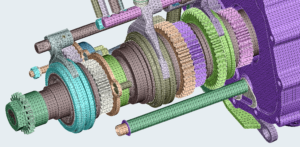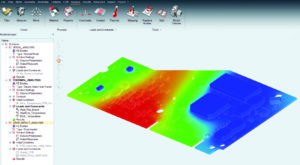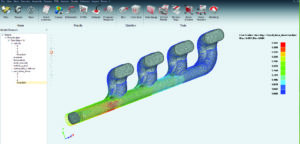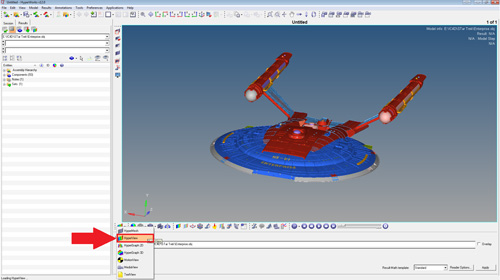Altair, a global technology company providing solutions in product development, high-performance computing (HPC), and data analytics, announced a significant software update. All of Altair’s software products have been updated with new features, including intuitive workflows that empower users to streamline product development, allowing customers to get to market faster.

The software update release expands on the number of solutions available for designers, engineers, and others to drive better decisions and accelerate the pace of innovation. It broadens the scope of the new user experience, enables access to more physics, data analytics, and machine learning, and makes the Altair software delivery method more flexible and accessible.

Some of the highlights:
• Structures
–Altair HyperWorks – new interface to Altair’s solution for high-fidelity computer-aided engineering (CAE) modeling and visualization, making learning easy and productivity high
–New subsystem entity for modular model configuration
–Altair SimLab – fatigue optimization
–Altair OptiStruct ¬– includes the addition of new explicit solution and expanded implicit non-linear solutions including 2D axisymmetry
–Altair SimSolid – includes advanced 3D seam weld connections to further improve speed
–Altair Radioss – employs a dramatic reduction in runtimes for virtual drop testing of electronics devices

• Fluids and Thermal
–HyperWorks CFD – provides engineers and experienced computational fluid dynamics (CFD) specialists with the most productive CFD pre- and post-processing capabilities to-date
–Altair AcuSolve – GPU acceleration yields 3-4 times increased speed while also supporting nucleate boiling, radiation, condensation/evaporation and multiphase fluid-structure interaction (FSI)
–Altair ultraFluidX – includes a new, more accurate wall model and overset grid technique
–Altair nanoFluidX – is three times faster than the previous version
• Industrial Design and Structures
–Altair Inspire integration of Altair SimSolid solver includes support and connector reaction forces, instantaneous reaction time modeling large PolyNURBS models, and improved geometry generation from optimization
–Inspire Studio – advanced morphing of any geometry type
• Manufacturing
–3D printing simulation available in Inspire with new unit cell lattice generation
• Electromagnetics and Multiphysics
–SimLab – electric motor modeling and coupling with AcuSolve and Altair Flux; accommodates ECAD file import (ODB++)
–Altair Feko – provides a component library tightly integrated with CADFEKO
–Altair FluxMotor now includes thermal and acoustics evaluation
–Flux includes several enhancements including those for modeling iron losses and skew type motors
• Systems Modeling
–Altair Activate – performs multi-physics system modeling with hardware-in-the-loop and Internet of Things (IoT) for digital twin development
–Integration of EDEM bulk material modeling with multibody dynamics simulation and hydraulics ideal for heavy equipment and agricultural applications
–Altair MotionView – has a two-wheeler vehicle dynamics library for motorcycles and scooters
–Altair Compose – OpenMatrix Language available in Jupyter Notebook
–Altair Embed – supports three additional target and two additional target families from ST Micro, VRTOS code modifications for MISRA compliance, and OpenCV DNN (Deep Neural Network) module integration
• Data Analytics
–Recent release of Altair Panopticon – platform for user-driven monitoring of real-time data – includes major update of cloud-based deployment, enabling users to build, modify, and share custom-designed functions and content easily via standard web browsers; hotfix to enable deployment at Nomura
–Altair Knowledge Hub – improved messages for troubleshooting and robustness; security hardening; more flexible Windows deployment; deployment on Azure; transformations including continuous binning and lookup join (refactoring for performance) and more
–Altair Monarch – complex Excel input support – “Excel Trapping”; PDF extraction improvements; user experience and UI improvements; enhanced column list and more
–Altair Knowledge Studio – new features including Keras model, model stacking, and pivot table; variable transformations node improvements with dataset and variable preview and re-ordering
• Smart Product Development
–Altair SmartWorks – major re-architecture of the edge orchestration and augmentation; ability to validate the edge application in real-time environments and deploy at scale
• HPC and Cloud
–Altair Access – updated “work from home” features; more responsive 3D remote visualization; internationalization; better job resource charts; two-factor authentication and single sign-on; share support on mobile
–Altair Accelerator – EDA workload support on AWS (with Rapid Scaling), Microsoft Azure, and GCP; 10x faster for dynamic workloads; container improvements; REST query API; IPv6
–Altair PBS Professional – scalability improvements towards exascale; Cray Shasta support; container enhancements for converged AI+HPC workloads; better system maintenance support
All products are available through the Altair licensing model, making access to all Altair’s software broader and more flexible.
Altair
www.altair.com/2020









